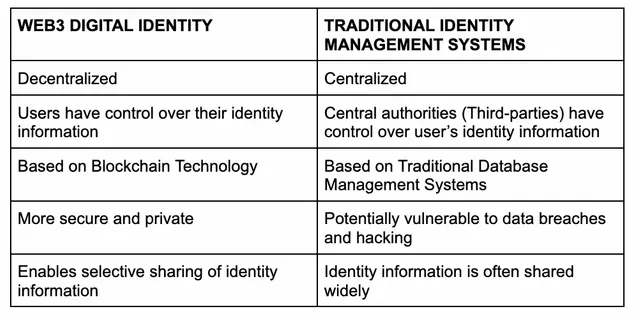Why Web3 Needs Digital Identity?
A Brief Introduction of Web3
Web3, which is short for Web 3.0, is the latest iteration of the World Wide Web that is being developed to create a more decentralized, secure, and transparent Internet. It is built on blockchain technology, which is a distributed ledger that enables secure and transparent peer-to-peer transactions without the need for intermediaries.

Web3 allows for new types of digital value creation and trade while also giving consumers more decentralized control over their own data and digital assets. It achieves this by enabling users — also referred to as peers — to communicate directly with one another without the assistance of intermediaries. This aids in avoiding the monopoly and power abuse that has plagued the conventional web.
The impact of Web3 on the internet cannot be over-emphasized. Web3 has revolutionized the way we manage data ownership and also improved data privacy. It has enabled new ways of value creation and exchange. Without the aid of middlemen or a central server, Web3 users can generate and trade digital assets like cryptocurrencies or non-fungible tokens (NFTs). This helps in monetizing their work and establishing direct contact with their followers, thus, creating new opportunities for musicians, artists, and other creatives.
Web3 provides more security and privacy because users control their own data and transactions. It also allows for further decentralization, which means that power and control are divided more equitably throughout the network. Finally, Web3 opens up new avenues for innovation and value generation by enabling previously unimaginable kinds of collaboration and trade. Overall, Web3 is a significant stride forward for the internet, and its effect will only grow in the coming years.
What is Web3 digital identity?
Web3 digital identity is a new approach to controlling our digital identities online that gives us back control. Web3 digital Identity helps in giving users the ability to own and manage their digital data rather than relying on large centralized corporations or governments to do it. This method is decentralized, which means it is more secure and private, and it allows us to pick with whom we share our information.

In Web3 digital identification systems, users can create and manage their identity in a secure, private and immutable manner by leveraging the power of blockchain technology, which provides a secure, decentralized and unchangeable record of digital transactions. This gives users the power to control their identity information and selectively share it with others while
maintaining their privacy and security.
Web3 digital Identity is an important advancement in the field of online identity management. Web3 digital Identity addresses the problems with conventional centralized identity systems, which are vulnerable to hacking and data breaches and may be monitored or censored by governments.
Web3 identity allows people more control over their online interactions by providing a safer, more private option that puts individuals in charge of their identification information. Decentralized apps and services that demand secure and dependable identity management might be made easier by enhanced trust and transparency. Web3 identification is ultimately a step in the right direction toward a more secure and independent digital society.
How does digital identity work in Web3?
Web3 makes use of Decentralized Identifiers to prove a user’s identity online without relying on centralized authorities. These identifiers are universally unique, verifiable, and permanent, and can be stored on blockchain networks. Decentralized Identifiers serve as the foundation of Web3 digital identity, allowing individuals to prove their identity without revealing personal information. This means that Web3 applications can use decentralized identifiers to confirm users‘ identities while giving users more control over their information. With decentralized identifiers, users can decide who has access to their personal data, giving users greater privacy and security online.
Web3 Digital Identity also makes use of Verifiable Credentials (VCs) to ensure identity information is secure and reliable. VC is an important component of digital identity systems built on the blockchain. VCs provide a secure and digital alternative to physical identity documents, allowing for easy verification of user identity. Examples of identity documents that can be issued as VCs include driver’s licenses, employee certificates, membership certifications, and digital passports.
Web3 Digital Identity vs Traditional Identity Management Systems
With the increasing importance of digital identity management, traditional centralized systems are facing security and privacy concerns. Web3 digital identity offers a decentralized alternative based on blockchain technology. In this chart, we will compare the differences between Web3 digital identity and traditional identity management systems.
WEB3 DIGITAL IDENTITY
TRADITIONAL IDENTITY MANAGEMENT SYSTEMS

Web3 Digital Identity Use Cases
Decentralized Social Media: Web3 digital identity enables users to control their identity information and content on decentralized social media platforms.
Decentralized Finance (DeFi): Web3 digital identity provides secure and reliable identity management for DeFi transactions, preventing fraud and building trust.
Decentralized Marketplaces: Web3 digital identity ensures secure and transparent identity management for buying and selling goods and services on decentralized marketplaces.
Decentralized Voting: Web3 digital identity enables secure and transparent identity management for voting systems, preventing voter fraud and ensuring fair elections.
Decentralized Healthcare: Web3 digital identity provides secure identity management for healthcare systems, allowing patients to control their medical records and keep their health data private and secure.
Web3 Digital Identity Solutions
Web3 digital identity solutions are created to empower users by giving them more control over their personal data and online identities. The Ethereum Name Service (ENS) is an example of web3 digital identity. ENS is a decentralized domain name system that allows users to connect their traditional readable domain names with their Ethereum addresses. Space ID is another solution for web3 digital identity, Space ID is a decentralized identity protocol that uses the Ethereum blockchain. Using Space ID, users can create and manage their decentralized identity profiles, which can be used for authentication and verification purposes.
CoinEx exchange has been actively supporting these Web3 digital identity solutions or projects. For example, CoinEx has integrated ENS into its exchange, allowing users to easily transfer funds to ENS domains instead of complicated wallet addresses. CoinEx has also supported the Space ID project and listed its native token, ID, on its exchange. Through these initiatives, CoinEx is helping to promote the adoption of Web3 digital identity solutions and empowering users to take control of their online identities.